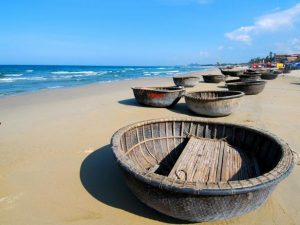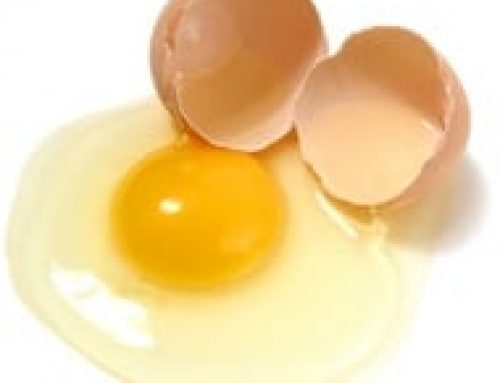Early Vietnam

History of Vietnam: Fishermen’s wicker boats on the beach at Danang, in Vietnam
The first people, with their dogs and baskets, probably reached Vietnam around 45,000 BC, coming along the coast from Africa to India and then Southeast Asia. These first settlers lived mostly by fishing, probably from small boats. And they collected seaweed, mussels, clams and shrimp along the shore.
More about early fishing
History of Cambodia
All our India articles
Vietnam’s central location, with great access to seafood, meant that many different groups settled here. So people in Vietnam had a lot of language and ethnic diversity.
When did Vietnam start to farm rice?
Around 2000 BC, people in North Vietnam near where Hanoi is now learned how to farm rice, probably from their northern neighbors in Shang Dynasty China, or from their western neighbors in Laos. Along the coast, people were still fishing, but inland they were farming. They also kept pigs. The fishers sold fish to the rice farmers, and they bought rice. Both groups were also using pottery, probably to ferment fish in order to preserve it and move it inland.
More about the history of rice
Where did pigs come from?
History of pottery
When did Vietnam enter the Bronze Age?
By 1200 BC, the Dong Son people learned how to make bronze tools and weapons, too. Probably they learned about bronze from Shang Dynasty China. But maybe it was from other Southeast Asian communities like Laos, which already had bronze. The inland people hunted wild boar and macaques, and maybe also wild chickens. Like other Southeast Asian people, Vietnamese people used boat-shaped coffins. They lived in houses on stilts to keep out snakes and cool them down. And they chewed betel nuts.
More about Laos
Shang Dynasty China
History of Vietnam: the Lac kings

Water buffalo
Vietnam became a state society around 600 BC, with Lac kings who supervised building big irrigation canals and dikes. These canals helped them to grow a lot of rice. Zhou dynasty Chinese writers first mentioned Vietnam around this time. (They called Vietnam “Lac“.) The Lac people kept water buffalo and chickens in addition to pigs and dogs. They grew beans to go with their rice.
More about water buffalo
And about chickens
History of rice
Vietnam’s Iron Age
Around 300 BC, the Lac people began to use iron tools. Again, these may have come from Laos.
History of iron
The Silk Road and Vietnam
Not long after the Silk Road was established, in the 200s BC, trading ships started to sail between India and China too. Some of these ships stopped in Vietnam, at the trading port of Hanoi. Vietnamese women started to produce silk cloth, just like in China, to sell to these trading ships.
More about Silk Road trade
China became more aware of Vietnam. In 208 BC, the Chinese Qin Dynasty conquered North Vietnam and made it part of China. Under the Han Dynasty that followed, many Han Chinese people moved to Vietnam and stayed there. Vietnamese people picked up a lot of Chinese customs and language. They started to drink tea. Government business was all in Chinese, and so was all education. The only writing system used in Vietnam was Chinese.
Qin Dynasty China
Han Dynasty China
Then a new strong Han emperor, Kuang Wu, also insisted on putting men in charge of women. Two sisters from a rich Lac family – Trung Trac and Trung Nhi – led a revolt against Han China as a result. For two years (39-41 AD) they held out, but then they were defeated and drowned themselves rather than let Chinese troops capture them. (This is a time with a lot of Afro-Eurasian women fighting for power – Shanakdakhete in Sudan, Cleopatra in Egypt, Agrippina in Rome.)
Shanakdakhete
Cleopatra
Agrippina the Younger
Meanwhile, the Cham ruled a lot of South Vietnam. As part of the Cham kingdom, South Vietnam traded with India, so many people there followed the Hindu (Indian) religion. New kinds of rice came to Vietnam from India about this time. But here, too, women produced silk for sale.
Then around 200 AD, the Han Dynasty collapsed. As China got weaker, India influenced Vietnam more. Many Vietnamese people became Buddhists.
What is Buddhism?
Guptan India
Ly Dynasty
After the collapse of the T’ang Dynasty, about 900 AD, North Vietnam became independent again. A new king, Ngo Quyen, united the country. But soon there were civil wars. In 980 AD, the Ly Dynasty took power. They abolished slavery, though it may not have made much practical difference. Northern Song emperors in China had a lot of power in Vietnam. The Song Dynasty invaded in the 1100s, but the Ly Dynasty fought them off.
What’s the Song Dynasty?
Tran Dynasty
Again Vietnam became independent, and again, under the Mongol emperor Kublai Khan, the Yuan Dynasty invaded Vietnam in the 1200s. To fight them off, in 1225, the Tran Dynasty took over in North Vietnam under the leadership of a part-Chinese child emperor, Tran Thai Tong, who married the last Ly dynasty ruler, Chieu Thanh. They defeated the Mongols in 1227. The Mongols invaded Vietnam again in 1284 and in 1287, but the Tran emperors, with help from Song Dynasty Chinese generals who had fled to Vietnam, defeated them both times.
The Tran emperors brought slavery back to Vietnam. They did engage in some redistribution of land to villagers, but under the control of rich families. At this time, Vietnam also started to produce cotton, just like China further north.
History of cotton
Buddhist monks
History of printing
There were large, powerful Buddhist monasteries. The Tran developed a way to write Vietnamese, so the government didn’t have to run in Chinese anymore. They printed books in Vietnamese. The Tran lost power in 1400.
Le Dynasty
From 1407 to 1427, the Ming Dynasty got control of Vietnam again, using new gunpowder weapons. The Chinese destroyed almost all the Vietnamese books and art and buildings. They mined a lot of gold and silver and sent it back to China. (China needed a lot of silver for their money.)
Silver and silver mines
China’s paper money crisis
They kept a census of the population and used it to draft men into the Chinese army. But in 1427, a man called Le Loi led a Vietnamese revolt to threw out the Chinese and established the Le dynasty.
Who invented gunpowder?
More about the Ming Dynasty
In the 1400s, the Cham again took over a lot of South Vietnam, until in 1471 the Le dynasty pushed them out, using, again, gunpowder weapons. Probably another reason that the Chinese lost control of Vietnam was that there was a lot of malaria in northern Vietnam and the Chinese soldiers would catch malaria and get sick when they invaded.
What is malaria?
The Le Dynasty came to power partly by using racism to form a sense of Vietnamese identity. Then they used racism to keep themselves in power, turning Vietnamese people against not only Chinese and half-Chinese people, but also against all other ethnic minorities in Vietnam.
The 1500s brought Vietnam a lot of Holy Roman Empire trading ships carrying new American stuff. In the early 1600s, Vietnam got peanuts and sweet potatoes from these traders. Soon peanut sauce and sweet potato noodles became part of Vietnamese food.
Where did peanuts come from?
And sweet potatoes?
Nguyen Dynasty
The Nguyen Dynasty took control of Vietnam in 1802.
In the 1850s, the French emperor Napoleon III took over Vietnam. Jesuit missionaries convinced many Vietnamese people to become Catholics instead of being Buddhists. By 1887, the French were openly ruling both south and north Vietnam.
Jesuit missionaries
What was going on in France?
History of coal
Why did they want rubber?
The French made Vietnam grow a lot more rice than ever before, so the French could sell it and make money from their colony. They built big irrigation canals in the Mekong Delta. And in the north, they started big coal mines. The French encouraged Vietnamese people to grow American crops like tobacco and rubber, African coffee, and Indian indigo dye, so the French could sell them. And they taxed salt.
Ho Chi Minh
Then during World War II, Japan took over Vietnam. Japan caused a huge famine in Vietnam during the war by taking Vietnam’s rice to feed the Japanese army. In the end of World War II, in 1945, Chiang Kai-Shek‘s Chinese army threw the Japanese out. The French negotiated to get the Chinese army out of Vietnam again, but under Ho Chi Minh, the Vietnamese fought the French too. Ho Chi Minh threw the French out of Vietnam in 1954.
World War II
Chiang Kai-Shek

Ho Chi Minh, the leader of the Vietnamese independence movement
But the old split between North Vietnam and South Vietnam soon resurfaced. Ho Chi Minh and North Vietnam followed China into Communism. South Vietnam appealed to the United States. A long civil war followed, with the United States fighting on the side of South Vietnam, while China and Russia helped North Vietnam. Ho Chi Minh died in 1969, but his army kept fighting. By 1973, the North Vietnamese won the war and took over ruling all of Vietnam from their capital, Ho Chi Minh City (Saigon).
Today, Vietnam is an independent and united country, ruled mainly from North Vietnam. But as China gets stronger, China will have more power in Vietnam again.

